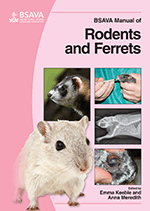
Full text loading...

Veterinary surgeons may be wary of anaesthetizing rodents as they are often less familiar with these species. Rodent anaesthesia can be challenging because, although the various species of rodent tend to be physically similar, they often differ in their response to anaesthetics. Similarly, the drug effects vary with the age, sex and strain of the animal. The relatively short life span of these species can result in a high proportion of aged patients being anaesthetized. For example, a 30-month-old rat presented for removal of a mammary tumour should be considered geriatric. These factors may explain why anaesthetic mortality in rodents has been higher than for other small animals such as dogs and cats. The general considerations are that of risk factor reduction, prevention of hypothermia, respiratory depression and analgesia. The chapter looks at Preanaesthetic preparations; Choice of anaesthetic; Intraoperative care and anaesthetic monitoring; Dealing with anaesthetic emergencies; and Postoperative care.
Rodents: anaesthesia and analgesia, Page 1 of 1
< Previous page | Next page > /docserver/preview/fulltext/10.22233/9781905319565/9781905319565.6-1.gif

Full text loading...











